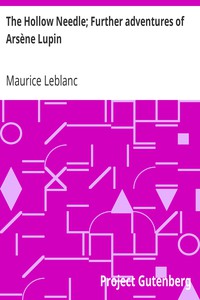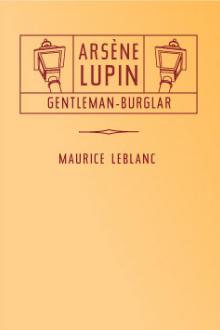The Hollow Needle; Further adventures of Arsène Lupin by Maurice Leblanc (speld decodable readers txt) 📖

- Author: Maurice Leblanc
Book online «The Hollow Needle; Further adventures of Arsène Lupin by Maurice Leblanc (speld decodable readers txt) 📖». Author Maurice Leblanc
Beautrelet at once presumed—and his surmise was no more than the logical consequence of the document—that, if there really was a direct communication between the land and the obelisk of the Needle, the underground passage must start from the Chambre des Demoiselles, pass under Fort Fréfossé, descend perpendicularly the three hundred feet of cliff and, by means of a tunnel contrived under the rocks of the sea, end at the Hollow Needle.
Which was the entrance to the underground passage? Did not the two letters D and F, so plainly cut, point to it and admit to it, with the aid, perhaps, of some ingenious piece of mechanism?
The whole of the next morning, Isidore strolled about Étretat and chatted with everybody he met, in order to try and pick up useful information. At last, in the afternoon, he went up the cliff. Disguised as a sailor, he had made himself still younger and, in a pair of trousers too short for him and a fishing jersey, he looked a mere scape-grace of twelve or thirteen.
As soon as he entered the cave, he knelt down before the letters. Here a disappointment awaited him. It was no use his striking them, pushing them, manipulating them in every way: they refused to move. And it was not long, in fact, before he became aware that they were really unable to move and that, therefore, they controlled no mechanism.
And yet—and yet they must mean something! Inquiries which he had made in the village went to show that no one had ever been able to explain their existence and that the Abbé Cochet, in his valuable little book on Étretat,[8] had also tried in vain to solve this little puzzle. But Isidore knew what the learned Norman archaeologist did not know, namely, that the same two letters figured in the document, on the line containing the indications. Was it a chance coincidence: Impossible. Well, then—?
[8] Les Origines d’Étretat. The Abbé Cochet seems to conclude, in the end, that the two letters are the initials of a passer-by. The revelations now made prove the fallacy of the theory.
An idea suddenly occurred to him, an idea so reasonable, so simple that he did not doubt its correctness for a second. Were not that D and that F the initials of the two most important words in the document, the words that represented—together with the Needle—the essential stations on the road to be followed: the Chambre des Demoiselles and Fort Fréfossé: D for Demoiselles, F for Fréfossé: the connection was too remarkable to be a mere accidental fact.
In that case, the problem stood thus: the two letters D F represent the relation that exists between the Chambre des Demoiselles and Fort Fréfossé, the single letter D, which begins the line, represents the Demoiselles, that is to say, the cave in which you have to begin by taking up your position, and the single letter F, placed in the middle of the line, represents Fréfossé, that is to say, the probable entrance to the underground passage.
Between these various signs, are two more: first, a sort of irregular rectangle, marked with a stripe in the left bottom corner, and, next, the figure 19, signs which obviously indicate to those inside the cave the means of penetrating beneath the fort.
The shape of this rectangle puzzled Isidore. Was there around him, on the walls of the cave, or at any rate within reach of his eyes, an inscription, anything whatever, affecting a rectangular shape?
He looked for a long time and was on the point of abandoning that particular scent when his eyes fell upon the little opening, pierced in the rock, that acted as a window to the chamber.
Now the edges of this opening just formed a rectangle: corrugated, uneven, clumsy, but still a rectangle; and Beautrelet at once saw that, by placing his two feet on the D and the F carved in the stone floor—and this explained the stroke that surmounted the two letters in the document—he found himself at the exact height of the window!
He took up his position in this place and gazed out. The window looking landward, as we know, he saw, first, the path that connected the cave with the land, a path hung between two precipices; and, next, he caught sight of the foot of the hillock on which the fort stood. To try and see the fort, Beautrelet leaned over to the left and it was then that he understood the meaning of the curved stripe, the comma that marked the left bottom corner in the document: at the bottom on the left-hand side of the window, a piece of flint projected and the end of it was curved like a claw. It suggested a regular shooter’s mark. And, when a man applied his eye to this mark, he saw cut out, on the slope of the mound facing him, a restricted surface of land occupied almost entirely by an old brick wall, a remnant of the original Fort Fréfossé or of the old Roman oppidum built on this spot.
Beautrelet ran to this piece of wall, which was, perhaps, ten yards long. It was covered with grass and plants. There was no indication of any kind visible. And yet that figure 19?
He returned to the cave, took from his pocket a ball of string and a tape-measure, tied the string to the flint corner, fastened a pebble at the nineteenth metre and flung it toward the land side. The pebble at most reached the end of the path.
“Idiot that I am!” thought Beautrelet. “Who reckoned by metres in those days? The figure 19 means 19 fathoms[9] or nothing!”
[9] The toise, or fathom, measured 1.949 metres.—Translator’s Note.
Having made the calculation, he ran out the twine, made a knot and felt about on the piece of wall for the exact and necessarily one point at which the knot, formed at 37 metres from the window of the Demoiselles, should touch the Fréfossé wall. In a few moments, the point of contact was established. With his free hand, he moved aside the leaves of mullein that had grown in the interstices. A cry escaped him. The knot, which he held pressed down with his fore-finger, was in the centre of a little cross carved in relief on a brick. And the sign that followed on the figure 19 in the document was a cross!
It needed all his will-power to control the excitement with which he was overcome. Hurriedly, with convulsive fingers, he clutched the cross and, pressing upon it, turned it as he would have turned the spokes of a wheel. The brick heaved. He redoubled his effort; it moved no further. Then, without turning, he pressed harder. He at once felt the brick give way. And, suddenly, there was the click of a bolt that is released, the sound of a lock opening and, on the right of the brick, to the width of about a yard, the wall swung round on a pivot and revealed the orifice of an underground passage.
Like a madman, Beautrelet seized the iron door in which the bricks were sealed, pulled it back, violently and closed it. Astonishment, delight, the fear of being surprised convulsed his face so as to render it unrecognizable. He beheld the awful vision of all that had happened there, in front of that door, during twenty centuries; of all those people, initiated into the great secret, who had penetrated through that issue: Celts, Gauls, Romans, Normans, Englishmen, Frenchmen, barons, dukes, kings—and, after all of them, Arsène Lupin—and, after Lupin, himself, Beautrelet. He felt that his brain was slipping away from him. His eyelids fluttered. He fell fainting and rolled to the bottom of the slope, to the very edge of the precipice.
His task was done, at least the task which he was able to accomplish alone, with his unaided resources.
That evening, he wrote a long letter to the chief of the detective service, giving a faithful account of the results of his investigations and revealing the secret of the Hollow Needle. He asked for assistance to complete his work and gave his address.
While waiting for the reply, he spent two consecutive nights in the Chambre des Demoiselles. He spent them overcome with fear, his nerves shaken with a terror which was increased by the sounds of the night. At every moment, he thought he saw shadows approach in his direction. People knew of his presence in the cave—they were coming—they were murdering him!
His eyes, however, staring madly before them, sustained by all the power of his will, clung to the piece of wall.
On the first night, nothing stirred; but, on the second, by the light of the stars and a slender crescent-moon, he saw the door open and figures emerge from the darkness: he counted two, three, four, five of them.
It seemed to him that those five men were carrying fairly large loads. He followed them for a little way. They cut straight across the fields to the Havre road; and he heard the sound of a motor car driving away.
He retraced his steps, skirting a big farm. But, at the turn of the road that ran beside it, he had only just time to scramble up a slope and hide behind some trees. More men passed—four, five men—all carrying packages. And, two minutes later, another motor snorted.
This time, he had not the strength to return to his post; and he went back to bed.
When he woke and had finished dressing, the hotel waiter brought him a letter. He opened it. It contained Ganimard’s card.
“At last!” cried Beautrelet, who, after so hard a campaign, was really feeling the need of a comrade-in-arms.
He ran downstairs with outstretched hands. Ganimard took them, looked at him for a moment and said:
“You’re a fine fellow, my lad!”
“Pooh!” he said. “Luck has served me.”
“There’s no such thing as luck with ‘him,’” declared the inspector, who always spoke of Lupin in a solemn tone and without mentioning his name.
He sat down:
“So we’ve got him!”
“Just as we’ve had him twenty times over,” said Beautrelet, laughing.
“Yes, but to-day—”
“To-day, of course, the case is different. We know his retreat, his stronghold, which means, when all is said, that Lupin is Lupin. He can escape. The Étretat Needle cannot.”
“Why do you suppose that he will escape?” asked Ganimard, anxiously.
“Why do you suppose that he requires to escape?” replied Beautrelet. “There is nothing to prove that he is in the Needle at present. Last night, eleven of his men left it. He may be one of the eleven.”
Ganimard reflected:
“You are right. The great thing is the Hollow Needle. For the rest, let us hope that chance will favor us. And now, let us talk.”
He resumed his serious voice, his self-important air and said:
“My dear Beautrelet, I have orders to recommend you to observe the most absolute discretion in regard to this matter.”
“Orders from whom?” asked Beautrelet, jestingly. “The prefect of police?”
“Higher than that.”
“The prime minister?”
“Higher.”
“Whew!”
Ganimard lowered his voice:
“Beautrelet, I was at the Elysee last night. They look upon this matter as a state secret of the utmost gravity. There are serious reasons for concealing the existence of this citadel—reasons of military strategy, in particular. It might become a revictualling centre, a magazine for new explosives, for lately-invented projectiles, for anything of that sort: the secret arsenal of France, in fact.”
“But how can they hope to keep a secret like this? In the old days, one man alone held it: the king. To-day, already, there are a good few of us who know it, without counting Lupin’s gang.”
“Still, if we gained only ten years’, only five years’ silence! Those five years may be—the saving of us.”
“But, in order to capture this citadel, this future arsenal, it will have to be attacked, Lupin must be dislodged. And all this cannot be done without noise.”
“Of course, people will guess something, but they won’t know. Besides, we can but try.”
“All right. What’s your plan?”
“Here it is, in two words. To begin with, you are not Isidore Beautrelet and there’s no question of Arsène Lupin either. You are and you remain a small boy of Étretat, who, while strolling about the place, caught some fellows coming out of an underground passage. This makes you suspect the existence of a flight of steps which cuts through the cliff from top to bottom.”
“Yes, there are several of those flights of steps along the coast. For instance, to the right of Étretat, opposite Bénouville, they showed me the Devil’s Staircase, which every bather knows. And I say nothing of the three or four tunnels used by the fishermen.”
“So you will guide me and one-half of my men. I shall enter
 Have you ever thought about what fiction is? Probably, such a question may seem surprising: and so everything is clear. Every person throughout his life has to repeatedly create the works he needs for specific purposes - statements, autobiographies, dictations - using not gypsum or clay, not musical notes, not paints, but just a word. At the same time, almost every person will be very surprised if he is told that he thereby created a work of fiction, which is very different from visual art, music and sculpture making. However, everyone understands that a student's essay or dictation is fundamentally different from novels, short stories, news that are created by professional writers. In the works of professionals there is the most important difference - excogitation. But, oddly enough, in a school literature course, you don’t realize the full power of fiction. So using our website in your free time discover fiction for yourself.
Have you ever thought about what fiction is? Probably, such a question may seem surprising: and so everything is clear. Every person throughout his life has to repeatedly create the works he needs for specific purposes - statements, autobiographies, dictations - using not gypsum or clay, not musical notes, not paints, but just a word. At the same time, almost every person will be very surprised if he is told that he thereby created a work of fiction, which is very different from visual art, music and sculpture making. However, everyone understands that a student's essay or dictation is fundamentally different from novels, short stories, news that are created by professional writers. In the works of professionals there is the most important difference - excogitation. But, oddly enough, in a school literature course, you don’t realize the full power of fiction. So using our website in your free time discover fiction for yourself. 




Comments (0)